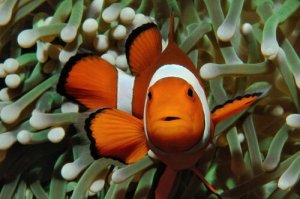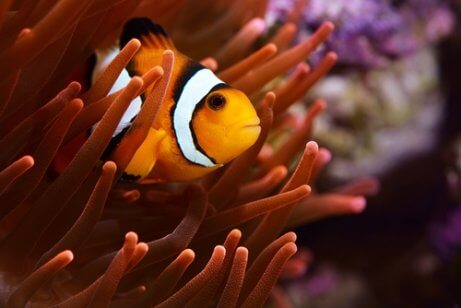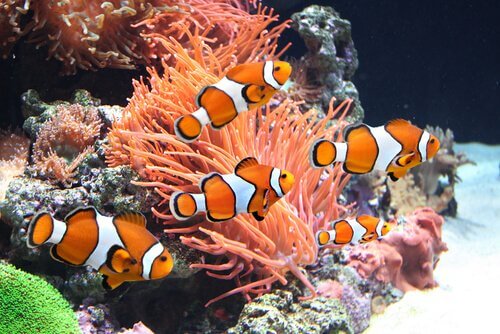Why is the Clownfish Orange?


Written and verified by the vet Eugenio Fernández Suárez
In the coral reefs of the tropics, there are hundreds of striking species of fish. This has influenced a team of researchers to decide to find out what gives the clownfish its orange color and its striking patterns.
Why is the clownfish orange?
The clownfish is orange in almost all its different subspecies. It is a unique fish in that lives in symbiosis with anemones. These plants give this beautiful fish protection, and, in turn, the clownfish gives food to the anemones. In addition to this, it works as a natural disease controller.
This famous fish has become the focus of a study carried out by the University of the Sorbonne. The study aimed to find out why the clownfish is orange with those distinct colorations in the different subspecies.
In the first place, the coloring of this fish is important for the species, as it allows them to recognize and organize themselves socially. The team discovered that at least nine species have more stripes as juveniles than adults.
The study also showed them that the stripes appear one after another, from head to tail. Some of these stripes disappear starting in reverse order when the animal approaches adulthood. Researchers also discovered that the ancestor of these animals had three stripes along their body.

The colors of the clownfish
Although clownfish are usually orange, there are species that are yellow, black, or pinkish. Normally, the stripes are white with black outlines. However, in some species they are bluish.
On its orange scales, this fish has a very thick mucus layer that lacks substances that activate the nematocysts. This is the reason why the skin of the clownfish makes it immune to the shocks of anemone, and that is why they can live happily among the anemone.
Instead of reacting to the anemone, the clownfish gradually gains immunity to anemone’s paralyzing toxins little by little. Eventually, it will become totally immune. This also allows the two species to take advantage of this microhabitat that offers both shelter and food.
Meet the clownfish
The clownfish is a species that feeds mainly on algae, invertebrates, and zooplankton. For that reason, they are considered omnivorous animals. As for their food supply, it depends on a hierarchy in which juveniles must remain close to the anemones.

These fish are also oviparous and hermaphroditic animals, which means they are born male, but can become female. The species is organized in matriarchies where pairs are monogamous. Curiously, when the females die, the male becomes a female.
These animals are found in all the tropical waters of the Indo-Pacific Ocean. They can be found on the coast of Madagascar, and the Maldives, as well as in China and Australia.
Although these animals aren’t threat of extinction, their prominence in a recent famous animated film has led to their capture for use in aquariums. As a result, this could well endanger this beautiful fish in the future.
In the coral reefs of the tropics, there are hundreds of striking species of fish. This has influenced a team of researchers to decide to find out what gives the clownfish its orange color and its striking patterns.
Why is the clownfish orange?
The clownfish is orange in almost all its different subspecies. It is a unique fish in that lives in symbiosis with anemones. These plants give this beautiful fish protection, and, in turn, the clownfish gives food to the anemones. In addition to this, it works as a natural disease controller.
This famous fish has become the focus of a study carried out by the University of the Sorbonne. The study aimed to find out why the clownfish is orange with those distinct colorations in the different subspecies.
In the first place, the coloring of this fish is important for the species, as it allows them to recognize and organize themselves socially. The team discovered that at least nine species have more stripes as juveniles than adults.
The study also showed them that the stripes appear one after another, from head to tail. Some of these stripes disappear starting in reverse order when the animal approaches adulthood. Researchers also discovered that the ancestor of these animals had three stripes along their body.

The colors of the clownfish
Although clownfish are usually orange, there are species that are yellow, black, or pinkish. Normally, the stripes are white with black outlines. However, in some species they are bluish.
On its orange scales, this fish has a very thick mucus layer that lacks substances that activate the nematocysts. This is the reason why the skin of the clownfish makes it immune to the shocks of anemone, and that is why they can live happily among the anemone.
Instead of reacting to the anemone, the clownfish gradually gains immunity to anemone’s paralyzing toxins little by little. Eventually, it will become totally immune. This also allows the two species to take advantage of this microhabitat that offers both shelter and food.
Meet the clownfish
The clownfish is a species that feeds mainly on algae, invertebrates, and zooplankton. For that reason, they are considered omnivorous animals. As for their food supply, it depends on a hierarchy in which juveniles must remain close to the anemones.

These fish are also oviparous and hermaphroditic animals, which means they are born male, but can become female. The species is organized in matriarchies where pairs are monogamous. Curiously, when the females die, the male becomes a female.
These animals are found in all the tropical waters of the Indo-Pacific Ocean. They can be found on the coast of Madagascar, and the Maldives, as well as in China and Australia.
Although these animals aren’t threat of extinction, their prominence in a recent famous animated film has led to their capture for use in aquariums. As a result, this could well endanger this beautiful fish in the future.
All cited sources were thoroughly reviewed by our team to ensure their quality, reliability, currency, and validity. The bibliography of this article was considered reliable and of academic or scientific accuracy.
- Buston, P. (2003). Social hierarchies: size and growth modification in clownfish. Nature, 424(6945), 145.
This text is provided for informational purposes only and does not replace consultation with a professional. If in doubt, consult your specialist.








